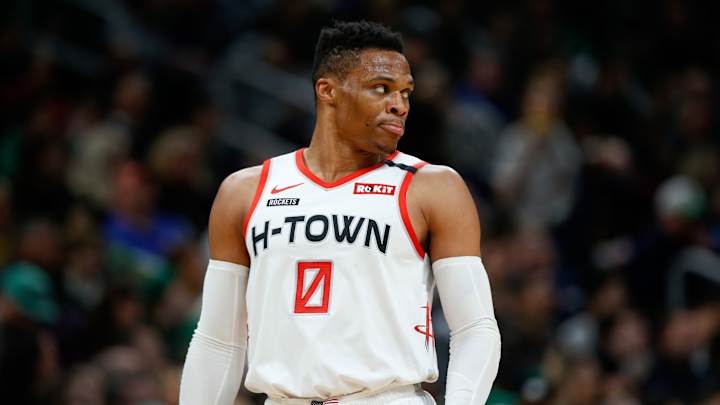How Russell Westbrook's Reformation Changed the Rockets' Season

The Rockets' acquisition of Robert Covington on Feb. 4 marked the official turning point of their season, but they truly kicked off their small-ball experiment shortly after the calendar turned to 2020. And the story of Houston's season can be best viewed through the lens of Russell Westbrook.
The 2016-17 MVP arrived in Houston in July 2019 to a chorus of questions regarding his fit alongside James Harden. Westbrook and Harden had been among the NBA's highest-usage players in recent seasons, and Westbrook's ugly three-point numbers portended a potentially shaky partnership. The question marks emerged early on.
Westbrook was able to remain productive in the season's opening months, generating offense largely through transition points, put-backs and isolation opportunities when Harden sat. But when both MVPs shared the floor, Westbrook spent significant stretches uninvolved in the offense. That isn't an implicit criticism of the Rockets. They've built a contender by allowing Harden to isolate to a historic degree. But that plan–while effective–has consequences. Westbrook suffered as a result.
Harden thrived in the opening portion of the season, in part due to the gravity created by Westbrook's simple presence on the floor. But a defensive adjustment in November provided a serious challenge. Opponents began to trap Harden nearly every time he crossed half-court, effectively forcing the Rockets to defeat teams with a 4-on-3 advantage. The situation on its face appeared enticing, but Houston struggled to take advantage of the Harden trap.
Capela was woefully unqualified as a downhill playmaker, while the Rockets' perimeter players hesitated to pull the trigger from beyond the arc. Westbrook faced a similar challenge, spending much of December marginalized in the half court. Without a bankable outside shot, his role in the offense diminished.
Capela's injury woes began in early January as he missed seven of 18 games before getting shipped to Atlanta. And in Capela's absence, Westbrook and the Rockets made perhaps their most consequential adjustment of the season. Westbrook moved into a strange point-center hybrid on the offensive end, often starting the game alongside Harden, P.J. Tucker, Robert Covington and Danuel House. Tucker is officially Houston's starting center, though on offense, he spends most of his time fanned out on the perimeter alongside Covington and House. Westbrook has filled the interior void to great effect.
Westbrook's role as an offensive center is most noticeable against the Harden trap. Capela would catch the ball inside the arc following a double-team of Harden and quickly freeze, unable (or unwilling) to pressure the defense with a few dribbles toward the tin. Westbrook doesn't share Capela's hesitation. He's excelled at being a decisive playmaker off the double team, quickly burying his head toward the lane with an extra defender out of the play. Rotate one defender to Westbrook, and he's likely to score at the tin or draw a foul. Collapse the defense, and an open three is created with ease.
Westbrook's foray into the center spot has also benefitted Houston against traditional defenses. The elimination of a true center has truly unlocked the paint for Westbrook and Harden, allowed each of them plenty of space in isolation. Opponents will use their best wing defender on Harden if they opt against the double team, hoping to survive on a stream of isolations. With the top defender hugging Harden, stopping Westbrook becomes a perilous task. The former Thunder star is notorious for bullying smaller point guards, bruising his way into the paint with a collection of post-ups. Brad Wanamaker and the Celtics were on the other end of Westbrook's fury on Feb. 11
Without a viable three-point stroke–Westbrook is shooting 28.5% from three since 2017-18–opponents have attempted to stifle Westbrook by guarding him with a true center. The opposing big man will sag off Westbrook to a severe degree, daring him to shoot while also attempting to cut off the angle to the rim. The strategy is more effective in theory than in practice. Westbrook uses the space as a runway to the rim, and as he enters the paint, he's an expert at contorting his body away from defenders. Westbrook torched Rudy Gobert and Utah on Feb. 9, taunting the French center throughout his 39-point performance.
Houston's point guard has sacrificed a significant share of offensive volume compared to his time with the Thunder, a trend that will continue as long as James Harden leads the way in Houston. But there's a chance Westbrook's next chapter will be the most satisfying of his career. He's found a true groove as Houston's de-facto point center, averaging 31.7 points, 8.1 rebounds and 6.8 assists per game since Jan. 1 while shooting a blistering 52.7% from the field.
Perhaps Westbrook will never enter the MVP discussion again given his place in Houston's offense. But if his efficiency holds steady, a return to the Finals isn't out of the question. Westbrook's reformation has changed the Rockets' season for the better.
